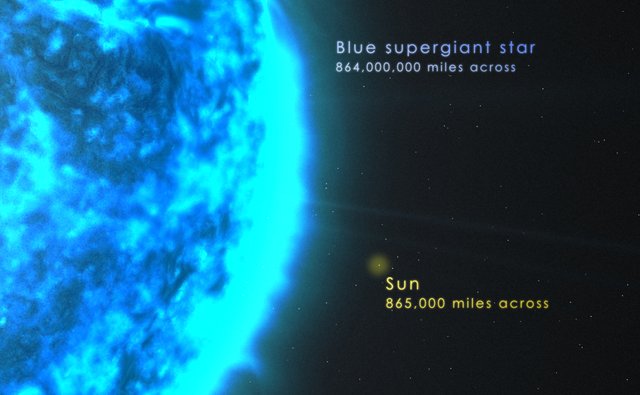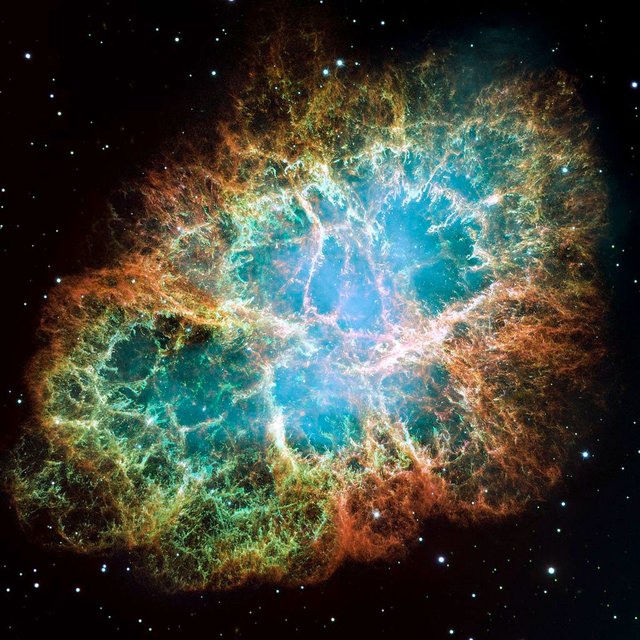Supergiant Stars and Hypergiant Stars, The Biggest and Brightest.
The Biggest Stars in the Universe are Defined as Supergiant and the Biggest of Those are Called Hypergiants
The Biggest and the Brightest

(Source)
At 3,500 to 20,000 Kelvin Supergiant Stars are Hot
Supergiant stars are some of the hottest and brightest stars. (However, white dwarfs can be hotter.)
Their properties are defined with a few different classes and subclasses: IB is supergiant IA for luminous supergiant stars and 0 (or IA+) for hypergiant. You can combine them like IAB for ones in the middle of each class because it is a continuum with no set boundaries. The mass of supergiant stars have a massive variance as well, ranging from 10 to 70 solar masses. [1] They are usually a thirty to five hundred times the size of the sun, but can even be as larger than one thousand times the size . Some like VY Canis Majoris can have 1800 times the radius of our sun. This would extend out to the orbit of Jupiter if it was where our sun is currently positioned. That is one big star. Another one, named Betelgeuse, outputs 135 thousand times as much energy as the sun. It has only 20 times the mass of the sun, with an extremely short lifespan. It is nearing the end of its life with only about one thousand years left of life. It has already existed for 8.5 million years, nothing compared to a star like ours, which is 4.5 billion years old and only halfway done with its life. That sun is a red star with a luminosity of 140 thousand times the size of the sun and a surface temperature of 3,500 kelvin. This star is brighter and larger, but not as hot as other types of stars. Blue stars are hotter, for example, the star Rigel. At a hot 11 thousand kelvin, it is over 3 times the temperature of Betelgeuse. It is slightly smaller too, only 17 times the mass of the sun and with a diameter of 62 times the sun. [2]
The Rarest Star
They are extremely rare compared to other types of stars. This is for many reasons including their lifetime. They live extremely short lives compared to other stars. This means in older galaxies and clusters, they have already died. Another reason for their rareness is how unlikely they are to form in the first place. Stars form a collapsing dust cloud. As the dust cloud collapses, it gets denser, and when that happens it breaks into pieces. Those pieces are usually on the smaller side. For a supergiant star to form it would require a dust cloud piece piece twenty or thirty times the average size, and that is very unlikely to exist.
A rare star with a short life, even when a lot brighter, is also a lot harder to find. We just do not observe them in globular clusters or elliptical galaxies because those are composed mostly of older stars. Our best chance is looking in spiral galaxies, as supergiants are sometimes in found in the arms. The too other galaxy formations which have the most are open clusters and irregular galaxies, as they are much younger types of galaxies.
(Citation)

(source)
The Limits
Back in 2010 a massive star was found that was about 300 solar masses. It is was located in a cluster of about one hundred thousand stars, where only four are bigger than 150 solar masses. This is one of the biggest stars we have seen to date, as the mass of stars is usually limited through mechanisms similar to their size. Only specific circumstances allow for a star to increase past about 150 solar masses. Remember that dust cloud that star formation begins from? Well, massive dust clouds exist that can be as large as two hundred thousand solar masses, which is more than enough to make a star of a few thousand solar masses. As we previously discussed the dust cloud needs to collapse to cause star formation. When this happens, it collapses into many smaller pieces due to gravity. This means the stars formed from the collapsed chunks of dust can only become so massive, without colliding with another star. This means that newly forming stars have a "soft" upper limit. (Meaning they usually do not surpass it). These newly forming stars also tend to radiate large amounts of energy which blows away matter both during and after star formation. Additionally, newly forming stars containing heavier elements tend to absorb more energy and heat surrounding gas. All of this means that less material is able to compact into the star and ends up being blown away once the star reaches a certain size. Some supergiant stars are blue (brighter) which must be less massive or red (darker) which can be larger. The brighter and hotter it is the more it radiates away. This is why that the hotter a star burns, the smaller its maximum size is.
So how, if the physics is stacked against the formation of very massive supergiant stars do some still form? Well, stars can overcome some of these limitations if while they are forming they actually eat another nearby star...
(Citation)
The Bigger They are, the Harder They Fall
The most massive stars go out in what's called a supernova. A supernova, from a massive star, is almost always from fusing iron. when you fuse iron you lose energy, opposed to all the earlier cycles a star goes through. This one lasts a few minutes to a few hours. When the star loses energy from fusing iron, and the outside collapses inward. When the outside collapses inward it produces a massive amount of energy in the star which then violently explodes outward. The explosions of supergiant stars are far greater than other stars. When supergiant stars explode, it is thought that they will leave behind a black hole, as most stars with a mass over 25 solar masses do.
(Citation)

(Source) and (Credit)
In the image above, the bright blue burst in the bottom left is a supernova.
In the End A Nebula is Left
When a star goes supernova a lot of matter is blasted in all directions into space. Most of it does not make it very far away but instead slowly spreads out in space. What is left is a supernova remnant, usually a black hole for supergiants, and a Nebula like the one pictured below. In my opinion these are one of the coolest looking things in space. They can last from thousands to millions of years.

(Source)
Nice job @anarchyhasnogods. :)
Very nice work! nice catalogue of large stars.
I really like the picture of the crab nebula :) So beautiful!
Oh, please, add this to the post!
The proportions are, simply, out of the possible imagination once known.
Oh yeah I've watched that I just couldn't find it again!